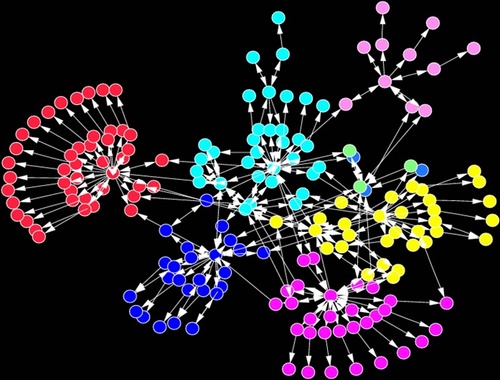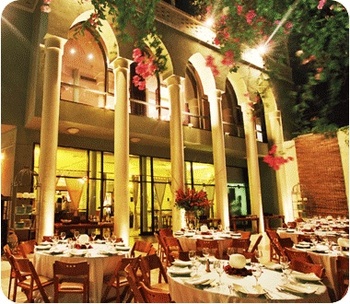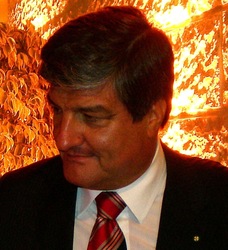Handling editor: Evelyn Sander
Complex Networks in Biology and Engineering:
From Principles to Applications
Eshel Ben-Jacob, School of Physics and Astronomy,
Tel-Aviv University, Israel,
Vito Latora, Dipartimento di Fisica, Universita di Catania
& INFN Sezione, Italy,
and Stefano Boccaletti, Embassy of Italy in Tel Aviv, Israel

An illustration of a complex network.
The first Italian-Israeli meeting on "Complex
Networks in Biology and Engineering: From Principles to Applications"
took place in Israel, at the Tel Aviv University, on October 24-25,
2007. The conference was sponsored by the Italian Embassy in Israel
and by the Tel Aviv University. The study of complex networks is
currently viewed as a hot topic in science, both for its
multi-disciplinary nature and for its innovative applications. Complex
networks appear in several systems from biology to computer science,
tuning and ruling most of the life activities of organisms and the
functioning of technological networks. Consequently, complex networks
theory has become an essential ingredient in the background of any
scientist. The main purpose of the meeting was to bring together a
small group of about thirty Italian and Israeli experts in complex
networks from many different fields (physics, computer science,
biology and engineering) to discuss the current techniques and
applications of network theory.
The Italian group was coordinated by Vito Latora, from the University
of Catania, Italy, and included researchers from CNR, INFN, ENEA, ICTP
(Trieste), ISI (Torino) and the universities of Roma, Padova, Catania
and Palermo, as well as from leading industries such as
STmicrolectronics. The Israeli participants were coordinated by Eshel
Ben-Jacobs from the Tel Aviv University, and included researchers from
the Technion, Tel-Aviv University, Haifa University, Ben Gurion
University, Hebrew University and the Weizmann Institute as well as
industrial participants from leading companies in the field.

The Marcel Gordon University Club.
The lectures were held at the The Marcel Gordon University Club (the
Green House) at Tel Aviv University which provided a very special warm
atmosphere for interactive lectures and discussions. There were many exciting topics
at the forefront of research in complex networks, such as the
principles of gene networks regulation, memory and learning in
neural networks, information processing by the immune network,
modeling of epidemic spreading, information flow and information
mining in the Internet, and synchronization phenomena in biological
and social networks. All the speakers were asked to
present part of their lectures in a more popular manner to be
accessible to students and scientists with different backgrounds
and goals.
The first day of work started with the opening and welcoming remarks
of the Italian Ambassador in Israel, His Excellency Sandro De
Bernardin, who described to the audience the huge body of cooperation
in science and technology that exists between Italy and Israel, and
how the Italian Government considers strategic to boost cooperation in
science and technology between the two countries.

His Excellency Sandro De Bernardin.
During the Opening Ceremony both the President and the Rector of the
Tel Aviv University stated how important are the ties between the
scientists of the University and the Italian system of research and
innovation. The Rector of the Tel Aviv University then signed a
Memorandum of Understanding between the Tel Aviv University and the
University of Catania that is intended to promote a strong future
collaboration between these two Organisms. The Memorandum was
countersigned by the Dean of the Faculty of Engineering at the
University of Catania, Prof. Luigi Fortuna.
Following the opening remarks, the first lecture was given by the
science attaché of Italy in Israel Stefano Boccaletti, who explained
how the intimate interplay between network topology and functionality
may lead to the emergence of collective phenomena such as
synchronization in connection with specific statistical properties
characterizing the graph connectivity. He was followed by Sorin Solomon, who
illustrated how understanding the fundamental principles of complex
networks can play a crucial role in extracting information from
systems such as WWW, Wikipedia, peer-to-peer, biological and cognitive
networks.
Irun Cohen (WIS) discussed how the immune system maintains the human
body by computing its current state through a network of interactions
of distributed cells and molecules. In particular, Cohen presented two
examples of the many system elements involved in immune computation:
the architecture of cytokine mediated cell connectivity and the
immunological homunculus (a dynamic representation of body biomarkers
inherent in one's repertoire of auto-antibodies).
Massimo Marchiori (University of Padova) spoke on social search
engines. Marchiori showed how society and technological progress have
changed the rules of the World Wide Web, introducing good but also bad
components, and how the social flows can be used to make up for a
better generation of search engines. Rosario Mantegna (University of
Palermo) discussed how one can construct networks of financial stocks,
based on the correlation between their time series. He also discussed
how such networks can be characterized in terms of minimum spanning
trees, and planar maximally filtered graphs.
There were three lectures on biological systems. Andrea Giansanti
(University of Roma La Sapienza) used hydrophobicity scales to
construct in various ways a protein network from the information
contained in the protein sequences. In particular, he showed how the
network metaphor can shed some light on the problem of the stability
and aggregation properties of acyl-phossphateses and of a class of
viral neuraminidases. Martin Kupiec talked about network perspective
of telomeres control. The importance of this question is
related to the fact that in multi-cellular organisms, telomere
shortening acts as a tumor suppressive mechanism. Replenishing
telomeres is one of the few essential steps that a normal human
fibroblast cell must take on its way to become malignant. He presented
two complementary approaches: computational and experimental ones that
were employed to identify the various pathways that regulate telomere
length, with focusing on genetic interactions that connect TLM genes
to the telomeres machinery. The third talk was that of Yitzhak Pilpel
(WIS), on coping with genetic and non-genetic perturbations. The
lecture was devoted to genetic circuits that allow them to respond
more efficiently to their environment, and to control the internal
stochastic fluctuation and genetic backup against external and
internal variability. New results about the structure of
redundancy-based circuits that provide cellular solution to genetic
and non-genetic fluctuations were presented.
Luigi Fortuna (University of Catania) showed how the synchronization
of dynamical networks of multiplexed chaotic systems with smooth
nonlinearities can be achieved, while Mattia Frasca (University of
Catania) studied how local interaction rules in a system of mobile
agents can be used to obtain a form of coordinated behavior and how
motion can influence epidemic spreading in such systems. In the final
talk of the day, Remo Pareschi (University of Molise) showed how to
model a situation where two networks come into contact and effectively
compose into a larger network, as it may happen, for instance, when
two enterprises are merged and the underlying communities of people
become a single one.
Yuval Shavit (TAU) gave the opening lecture of the second day,
presenting the first results of DIMES, a project to map the topology
of the Internet. The DIMES project is based on a light-weight
software measurement agent to be downloaded by volunteers around the
world. The DIMES agent can be executed on every PC and allows mapping
the Internet and tracking its evolution in time in several levels of
granularity from the fine router level to the coarse Autonomous System
(AS) level. In his lecture, Santo Fortunato (ISI Foundation, Torino)
concentrates on the problem of how to detect community structures in a
complex network. He discusses three main aspects of the problem: the
definition(s) of community, the evaluation of partitions and the issue
of hierarchies.
Shlomo Havlin talked about a central question in epidemics that is how
to minimize the number of immunized nodes (people, computers etc) and
still stop the spreading of epidemics. He reviewed and compared
several efficient immunization methods recently developed. Vittoria
Colizza (ISI Foundation, Torino) discussed the results of large-scale
computational approaches for the study of global epidemics, showing
the effect of complex real world transportation networks in the
spreading pattern and in the forecast of emerging diseases.
Jesus Gomez-Gardenes (Scuola Superiore di Catania) lecture was on
evolutionary game theory models on complex topologies. In particular
Gomez-Gardenes showed how scale-free networks allow the survival of
cooperative behavior even when selfish actions provide higher fitness
(reproductive success). Ginestra Bianconi (ICTP, Trieste) discussed
how to introduce the concept of entropy to characterize network
ensembles with the same degree distribution, the same
degree-correlations or the same community structure of any given real
network. One main result is that the ensembles with fixed scale-free
degree distribution have smaller entropy than the ensembles with
homogeneous degree distribution, indicating a higher level of order in
scale-free networks.
David Horn (TAU) talked about new approach to analyze enzymatic
profiles of metagenomes. Recent genomic studies of microbial
communities have become an important research trend, displaying
results that turn out to be characteristic to the environments in
which these communities are found. Thus networks of organisms are
represented by their overall genetic content. It was shown that
Applying the new Specific Peptides (SPs)method to metagenomes, it is
possible to identify large numbers of putative enzymes, allowing us to
construct an Enzymatic Profile for the metagenome in question which is, a
step toward capturing relevant metaproteomic information.
Ron Meir (Technion) talked about optimal dynamic state estimation by
neural networks based on recursive spike train decoding. Organisms
acting in uncertain dynamical environments often employ exact or
approximate Bayesian statistical calculations in order to continuously
estimate the environmental state, integrate information from multiple
sensory modalities, form predictions and choose actions. It was shown
that such computations can be implemented using a network of neurons
whose activity directly represents a probability distribution across
the possible "world states." In this lecture rigorous mathematical
results from the theory of continuous time point process filtering
were used to show how optimal real-time state estimation and
prediction may be implemented and relate the required network
properties to the statistical nature of the environment, thereby
quantifying the compatibility of a given network with its
environment. Yael Hanein (TAU) talked of a set of novel neural network
engineering tools suited for studying function-from relationship in
neural networks. In particular he discussed a recently developed
carbon nanotube based scheme to engineer neural networks with
pre-defined geometries and to facilitate very high resolution
electrical recordings and stimulations from these systems.
Vittorio Rosato (ENEA, Roma) focused on critical infrastructure
networks, such as the electrical power transmission networks and the
Internet He showed how such networks often display effects which are
seldom predictable on the basis of their normal behavior, and how
infrastructures are also strongly interdependent, as the operability
of one of them depends on the correct operability of the
others. Matteo Lo Presti (STMicroelectronics) presented some of the
activities of the STMicroelectronics, one of the world's largest
semiconductor companies, related with complex networks. In particular
he discussed examples of STMicroelectronics activities such as: energy
saving in home appliances, efficient solutions in factory automation,
new sensors for medical image diagnosis, high scale integration and
remote monitoring on cardiac applications, new solutions for
industrial and service robotics.
The meeting ended with two more general public lectures. Uri Alon's
(WIS) talk highlighted one of the aspects of simplicity in system
biology: biological regulation networks appear to be built of a small
set of recurring interaction patterns, called network motifs. In
particular, Alon discussed how complicated biological networks made of
interconnected motifs can be understood in terms of the dynamics of
individual network motifs. Finally, Shimon Marom (Technion) discussed
how measurements from large-scale recurrent networks of biological
neurons provide a unique opportunity to observe and define issues
pertaining to representation of environmental objects.
The meeting provided a unique forum for exchanging new ideas for
initiating joint projects between Italian and Israeli scientists and
also between academia and industry, and for strengthening scientific
cooperation.